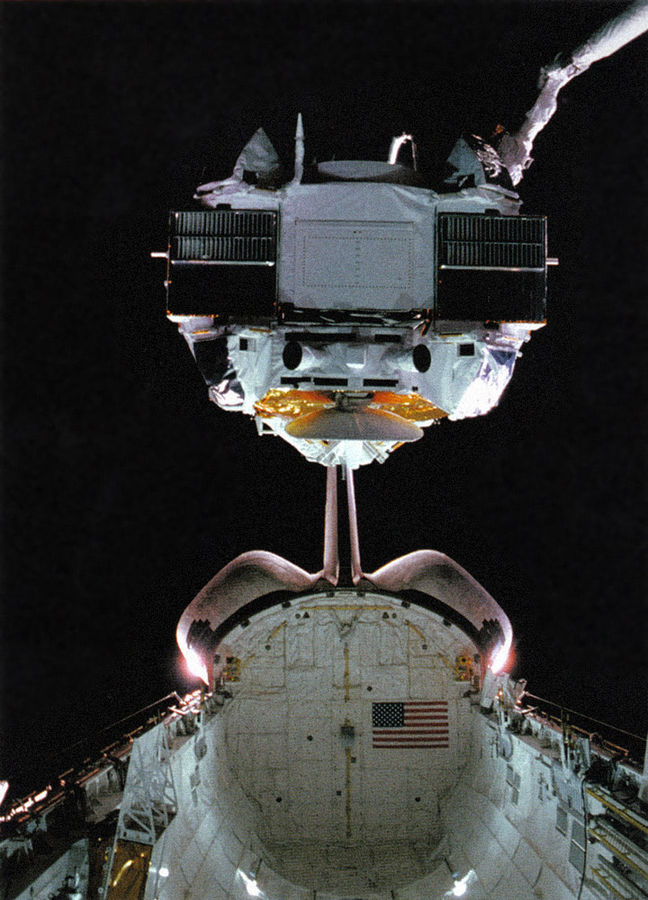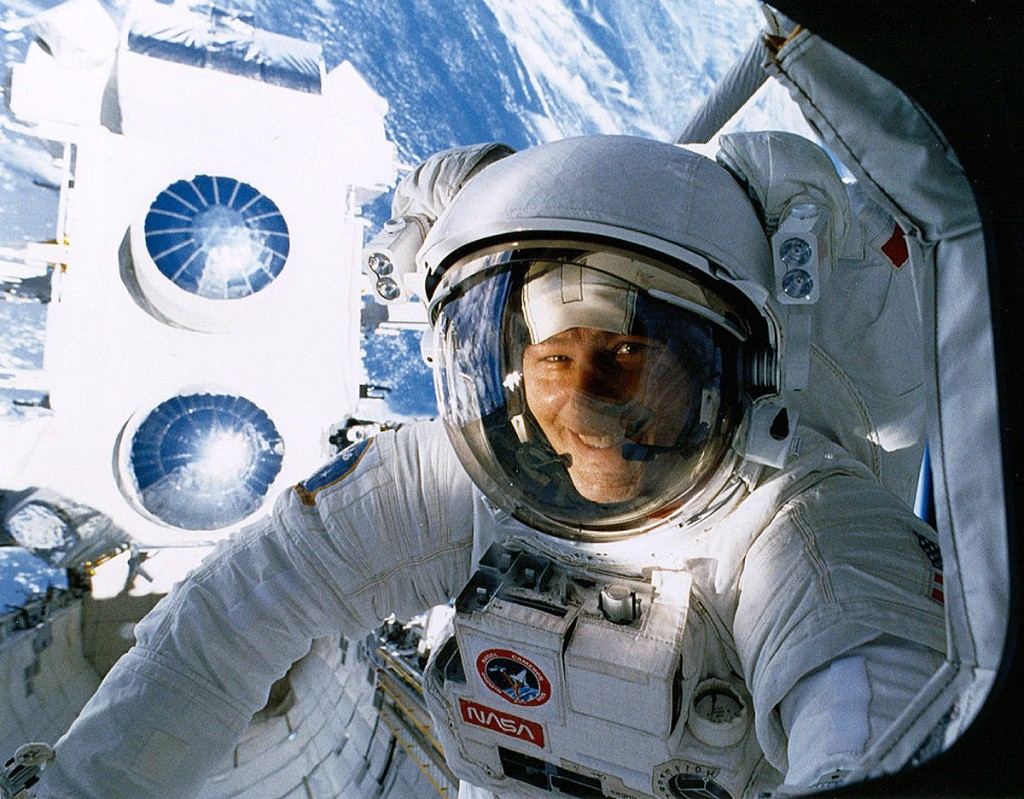Looking Back: The Legacy of the Compton Gamma Ray Observatory
- By Maggie Masetti
- April 13, 2016
- Comments Off on Looking Back: The Legacy of the Compton Gamma Ray Observatory
There are great observatories – and then there are “Great Observatories,” a title given to four space telescopes launched in the 1990s/early 2000s, each studying a different wavelength of light. The Hubble Space Telescope, primarily looking at visible light, you are likely familiar with; it was the first launched and just celebrated its 25th birthday. The Spitzer Space Telescope is going on 13 years of infrared observations. The Chandra X-ray Observatory, launched in 1999 by the Space Shuttle Columbia, is still looking at X-rays. And then there is the Compton Gamma Ray Observatory (CGRO), which also just passed the 25th anniversary of its launch.
CGRO was launched aboard the Space Shuttle Atlantis (STS-37) on April 5, 1991. At 17 tons, it was the heaviest scientific payload flown. Two days later, the observatory was set for deployment from the shuttle payload bay when the high-gain antenna became stuck. In an unscheduled space walk, astronauts Jay Apt and Jerry Ross were able to pull on the antenna with sufficient force to free it and the observatory was successfully deployed.
CGRO primarily made gamma-ray observations, with some X-ray capability. It had four main telescopes, and flew for 9 years. We thought we would catch up with two scientists involved with the mission, both of whom work here at NASA Goddard, to talk a bit about the scientific legacy of this important mission. Dr. Neil Gehrels was the Project Scientist for CGRO, and Dr. David Thompson was involved with the satellite’s EGRET instrument.
Blueshift: What were the mission science goals for CGRO? What did scientists hope to learn with it?
Thompson: The first goal of CGRO was to map for the first time the entire sky over a broad range of gamma-ray energies. As the most energetic form of light, gamma rays were expected to reveal information about some of the most energetic phenomena in the universe, including gamma-ray bursts, supernovae, galactic structure and dynamics, pulsars, quasars, and black holes. This is a summary from the pre-launch NASA Facts document.
Gehrels: CGRO is one of the four NASA Great Observatories to explore the universe across the electromagnetic spectrum: infrared (Spitzer), visible (Hubble), X-rays (Chandra) and gamma rays (Compton). It performed the first sensitive surveys of the sky in gamma ray light. Scientists were very excited to learn what was out there in gamma rays.
Blueshift: What role did you have with the mission?
Thompson: I was one of the scientists who designed, built, tested, and used the data from the Energetic Gamma-Ray Experiment Telescope (EGRET), the one of the four CGRO instruments that observed the most energetic gamma rays. Before the mission started, I was one of the scientists who helped convince NASA that the science from CGRO would be exciting enough that the satellite should be built. That meant giving talks to a number of NASA panels, including the NASA Administrator, as well as a visit to the Office of Management and Budget to try to persuade the financial side of government that this was a project worth funding.

David Thompson (right) and fellow CGRO scientist Robert Hartman reviewing some 1993 EGRET results in the EGRET data analysis room at NASA Goddard Space Flight Center.
Gehrels: I was the Project Scientist for the mission from the time of its launch in 1991 through to the de-orbit maneuver in 2000. Prior to me Dr. Don Kniffen led the mission as Project Scientist from its inception until the launch when he retired. It was a thrill to oversee the science of the mission and the science teams. There were new discoveries every week. I worked with the program scientists at NASA Headquarters to organize press conferences, support the science teams for each of the 4 instrument to analyze and publish their data, and give many presentations on the mission science at conferences and universities.
Blueshift: Can you tell us about a particularly memorable experience working on CGRO?
Thompson: Aside from making scientific discoveries with EGRET, I most remember my interactions with the astronaut crew who were responsible for putting CGRO in orbit. I did a couple of science briefings for the crew, and I was really impressed with their enthusiasm for the mission, not only because it was going to be the heaviest astrophysics payload the Shutttle had ever carried, but also because they were excited to be a part of a mission that they knew would make important scientific advances.
Gehrels: When the BATSE team found that gamma-ray bursts were occurring uniformly across the sky, scientists were initially unsure if this meant that they were caused by exploding stars in distant galaxies or star-quakes on neutron stars in the halo of our own Milky Way galaxy. We organized debates and data challenges to find the answer. Eventually it became clear that that the correct answer was exploding stars.

In 1995, astronomers held an event to debate the scientific evidence about the distance to gamma-ray bursts. At the time, it was unclear whether they originated in our galaxy or beyond. At the debate, scientists were given a set of badges so that they could display which side of the debate they were on – galactic, cosmological or other.
Blueshift: What do you consider to be the most exciting or important discovery that came from CGRO?
Thompson: I think most of us would agree there were two standout discoveries. The first was the finding by the Burst and Transient Source Experiment (BATSE) that the mysterious gamma-ray bursts were coming uniformly from all directions in the sky, implying that they were probably from very distant sources. The second was our EGRET discovery that the gamma-ray sky was filled with blazars, a type of quasar (an object powered by a black hole millions to billions times the mass of our sun) with a jet of subatomic particles shooting out in our direction at nearly the speed of light. This was a completely unexpected result.
Gehrels: I agree with Dave Thompson that the highlight discoveries of the mission were the uniform distribution of gamma-ray bursts and gamma-ray blazars. Two other amazing results were the beautiful maps of radioactivity in the Milky Way by COMPEL and antimatter from the center of the Milky Way by OSSE. The COMPTEL map was of a gamma-ray line from the decay of the isotope 26-Al produced in supernova explosions. The map showed where supernovae had exploded over the past million years. The OSSE map was of a gamma-ray line from the annihilation of positron antimatter. It showed where positrons were produced in supernovae and pulsars near the center of the Galaxy. Positrons are the antiparticle of elections and produce gamma-rays when they annihilated with elections in the region.

When CGRO launched, most astronomers thought gamma-ray bursts were related to dense neutron stars in our galaxy. With enough bursts, they thought, the distribution of GRBs would concentrate in certain regions, such as the galactic plane. Instead, BATSE showed that gamma-ray bursts occur all over the sky and their distribution bears no sign of the galaxy’s underlying structure. This was compelling evidence GRBs were exploding in distant galaxies, an interpretation later shown to be correct.
Credits: NASA/BATSE Team
Blueshift: How far has gamma-ray astronomy come since the launch 25 years ago? What are you still hoping to discover?
Thompson: Thanks to the achievements from the CGRO instruments, NASA followed up with the Fermi Gamma-ray Space Telescope, launched in 2008 and still operating. The two Fermi instruments have built on the CGRO results to show just how varied and dynamic the gamma-ray sky is. Fermi has found new types of gamma-ray-emitting objects (like gamma-ray binary star systems) and surprising new aspects of known objects (like huge flares from the Crab Nebula). The Fermi studies have solved some of the puzzles left after the CGRO mission (like showing that supernova remnants really can produce energetic cosmic-ray particles) and have tackled new problems, like the nature of the dark matter that fills the universe. Fermi scientists are still working on that last one, having ruled out some possibilities but not yet finding the answer. There are still mysteries in the gamma-ray sky, though. About one-third of the more than 3000 gamma-ray sources seen by Fermi’s main instrument, the Large Area Telescope, do not seem to be associated with known astrophysical objects. Fermi scientists are still scratching their heads and doing in-depth studies of these. Ultimately, we will need other follow-on missions beyond Fermi to continue the search of the energetic universe.
Gehrels: CGRO made the pioneering observations of the gamma-ray sky during its nine years in orbit. Since we found new sources all over the sky, there were many questions raised by the CGRO discoveries. These led scientists to propose new missions to NASA in the most exciting areas. Two missions resulted, the Fermi Gamma-ray Space Telescope described by Dave Thompson and the Swift Gamma Ray Burst Explorer which I’ll discuss. Swift has observed gamma-ray bursts in great detail and learned that they are caused by both exploding stars and merging neutron stars. In both cases, a new black hole is formed. We now like to say that gamma-ray bursts are the birth cries of black holes. Looking to the future, we would like to use gamma-ray bursts to find the explosions from the first stars in the universe and to study the production of new elements across cosmic time.

1st Compton Symposium: Neil Gehrels, Martin Rees, Don Clayton, Jerry Fishman, Chip Meegan, John Horack
Credit: NASA
Blueshift: Thank you for your time!
After a long and active career in space, CGRO ultimately lost a gyro, and the telescope was deliberately and safely de-orbited. It re-entered the Earth’s atmosphere in June of 2000, where it landed in the Pacific Ocean. Fun fact – this was NASA’s first intentional controlled de-orbit of a satellite. This video was taken of CGRO over the Pacific Ocean during de-orbit maneuvers. The spacecraft is seen to start tumbling as it plunges into the atmosphere.
If you’d like to read more about CGRO, its discoveries, and the “good old farm boy whack” it took to release its antenna, here is a NASA 25th Anniversary feature. The Imagine the Universe website also has a special exhibit featuring CGRO.




